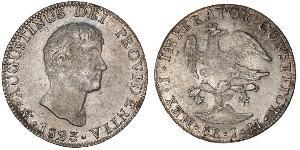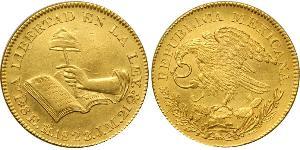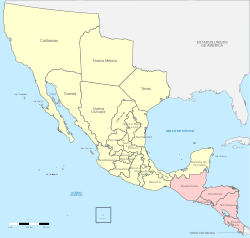|
|||||||
|
|
|||||||
| First Mexican Empire (1821 - 1823)from the Wikipedia | Read original article |
| Mexican Empire | ||||||
| Imperio Mexicano | ||||||
|
||||||
|
||||||
| Motto Religión, Independencia, Unión "Religion, Independence, Union" |
||||||
| Capital | Mexico City | |||||
| Languages | Spanish | |||||
| Religion | Roman Catholicism | |||||
| Government | Constitutional Monarchy | |||||
| Emperor | ||||||
| - | 1822–1823 | Agustín I | ||||
| Regent | ||||||
| - | 1821–1822 | Agustín de Iturbide | ||||
| - | 1822 | Nicolás Bravo Rueda | ||||
| Legislature | Congress | |||||
| - | Upper house | Senate | ||||
| - | Lower house | Chamber of Deputies | ||||
| History | ||||||
| - | Independence of Mexico | September 27, 1821 | ||||
| - | Agustín I of Mexico | July 21, 1821 | ||||
| - | Monarchy overthrown | March 19, 1823 | ||||
| Area | 4,925,283 km² (1,901,662 sq mi) | |||||
| Currency | Mexican real | |||||
| Today part of | ||||||
The Mexican Empire (Spanish: Imperio Mexicano) was the first independent post-colonial state in Mexico. It was the only former colony of the Spanish Empire to establish a monarchy after independence. It existed from the signing of the Treaty of Córdoba in 1821 until the emperor's abdication in 1823 and the proclamation of the Federal Republic in 1824. A second Mexican Empire was briefly reestablished in 1864.
The territory of the Mexican Empire corresponded to the old Viceroyalty of New Spain, excluding the Captaincies General of Cuba, Santo Domingo and the Philippines. The lands of the former Captaincy General of Guatemala were also annexed to the Empire shortly after its establishment. The first and only monarch of the state was Agustín de Iturbide, reigning as Agustín I of Mexico.[1]
Contents
History[edit]
The Mexican parliament intended to establish a commonwealth under the Spanish king, Ferdinand VII. King Ferdinand, however, refused to recognize Mexico's independence and said that Spain would not allow any other European prince to take the throne of Mexico. Instead, by request of Parliament, the prominent general and president of the regency Agustín de Iturbide was proclaimed emperor of Mexico.
The First Mexican Empire was short-lived, lasting less than two years, and was ruled by only one emperor, Agustín I of Mexico, who reigned for less than eight months. A republican rebellion based on the Plan of Casa Mata then overthrew the First Empire, establishing a Federal Republic of the United Mexican States in 1824.
Background[edit]
The various independentist factions in revolutionary Mexico coalesced around three principles, or "guarantees," for Mexican independence from Spain: that Mexico would be an independent constitutional monarchy governed by a conservative European prince; that criollos and peninsulares would henceforth enjoy equal rights and privileges; and that the Roman Catholic Church would retain its privileges and position as the official religion of the land. These Three Guarantees formed the core of the Plan of Iguala, the revolutionary blueprint which, by combining the goal of independence and a constitution with the preservation of Catholic monarchy, brought together all factions.[2]
After officially declaring independence on 28 September 1821, the Mexican parliament intended to establish a commonwealth whereby the King of Spain, Ferdinand VII, would also be emperor of Mexico, while both countries would be governed by separate laws and form separate legislative bodies. Should the king refuse the position, the law provided for another member of the House of Bourbon to accede to the Mexican throne. Ferdinand VII, however, refused to recognize Mexico's independence and said that Spain would not allow any other European prince to take the throne of Mexico.
Establishment[edit]
|
Part of
a series on the
|
|---|
| History of Mexico |
 |
|
Spanish rule
|
| Timeline |
| Mexico portal |
General Agustín de Iturbide, a Mexican criollo who led the insurgents in the final phases of the war, was elected head of the provisional government and of the regency which held the imperial power while a monarch was chosen. Iturbide was extremely popular after his successes in the war of independence, and on the night of 18 May 1822 a mass demonstration led by the Regiment of Celaya, which Iturbide had commanded during the war, marched through the streets and demanded that their commander-in-chief accept the throne himself.
On 19 May 1822, the Sovereign Congress named Iturbide emperor. On 21 May it issued a decree confirming this appointment, which was officially a temporary measure until a European monarch could be found to rule Mexico. Iturbide's official title was, "By Divine Providence and the National Congress, First Constitutional Emperor of Mexico" (Spanish: Por la Divina Providencia y por el Congreso de la Nación, Primer Emperador Constitucional de México). His coronation took place on 21 July 1822 in Mexico City.
As factions in the Congress began to sharply criticise Iturbide and his policies, the emperor decided on 31 October to dissolve the body.[3] This enraged the commander of the garrison at Veracruz, Antonio López de Santa Anna, who would later be President of Mexico during the secession of Texas and the disastrous Mexican-American War. Santa Anna and his troops revolted against Iturbide and proclaimed a republic on 1 December.
Defeat and abolition[edit]
Several insurrections arose in various Mexican provinces beginning in December 1822, but they were all put down by the Imperial Army except for Santa Anna's forces in Veracruz. Santa Anna had secretly persuaded General Echávarri, the commander of the Imperial forces, to switch sides and support the revolution when it was ready to be proclaimed throughout Mexico.
In December 1822, Generals Santa Anna and Guadalupe Victoria wrote and signed the Plan of Casa Mata, an agreement between these two generals, amongst other Mexican generals, governors, and high-ranking governmental officials, to abolish the monarchy and replace it with a republic. This plan did not recognize the First Mexican Empire and called for the convening of a new Constituent Congress. The insurrectionists sent their proposal to the provincial governments and requested their adherence to the plan. In the course of just six weeks, the Plan of Casa Mata travelled to such remote places as Texas, and almost all the provinces supported the plan.
By accepting the plan, a provincial government withdrew its allegiance from the Imperial government and assumed sovereignty within its province. By the agreement with Echávarri, the Plan of Casa Mata was proclaimed throughout Mexico on 1 February 1823. Emperor Agustín was left isolated with little support outside of Mexico City and a few factions of the Imperial Army. Consequently, he re-installed the Congress, which he had previously abolished, abdicated the throne, and fled the country on 19 March 1823. Santa Anna and the other proponents of the Plan of Casa Mata went on to oversee the drafting of a new constitution and the establishment of the First Mexican Republic the following year.
Territory[edit]
Under the First Empire Mexico reached its greatest territorial extent, controlling all of the mainland territories of the Viceroyalty of New Spain from northern California to Costa Rica, including the provinces of Central America (excluding Panama, which was then part of Colombia), which joined the Empire shortly after their independence.[4]
However, after the emperor abdicated, the Central American provinces seceded to form the Federal Republic of Central America, with only the province of Chiapas choosing to remain a part of Mexico. Subsequent territorial losses over the next several decades (principally to the United States) would eventually reduce Mexico to less than half its maximum extent.
Political subdivisions[edit]
The first Mexican empire was divided into the following intendences:
See also[edit]
Bibliography[edit]
- Arcila Farias, Eduardo. El siglo ilustrado en América. Reformas económicas del siglo XVIII en Nueva España. México, D. F., 1974.
- Calderón Quijano, José Antonio. Los Virreyes de Nueva España durante el reinado de Carlos III. Sevilla, 1967-1968.
- Céspedes del Castillo, Guillermo. América Hispánica (1492-1898). Barcelona: Labor, 1985.
- Hernández Sánchez-Barba, Mario. Historia de América. Madrid: Alhambra, 1981.
- Konetzke, Richard. América Latina. La época colonial. Madrid: Siglo XXI de España, 1976.
- Navarro García, Luis. Hispanoamérica en el siglo XVIII. Sevilla: Universidad de Sevilla, 1975.
- Pérez-Mallaína, Pablo Emilio et al. Historia Moderna. Madrid: Cátedra, 1992.
- Ramos Pérez, Demetrio et al. América en el siglo XVII. Madrid: Rialp, 1982-1989.
- Ramos Pérez, Demetrio et al. América en el siglo XVIII. Madrid: Rialp, 1982-1989.
- Rubio Mañé, Ignacio. Introducción al estudio de los virreyes de Nueva España, 1535-1746. Mexico City, 2nd ed., 1983.
References[edit]
- ^ "Primer Imperio Mexicano". La Guía. Retrieved 28 October 2014.
- ^ Michael S. Werner (2001). Concise Encyclopedia of Mexico. Taylor & Francis. pp. 308–9.
- ^ Christon I. Archer (2007). The Birth of Modern Mexico, 1780-1824. Rowman & Littlefield. p. 220.
- ^ Quirarte, Martín (1978). Visión Panorámica de la Historia de México (11th ed.). Mexico: Librería Porrúa Hnos.
External links[edit]
| Wikimedia Commons has media related to First Mexican Empire. |
|
||||||||||||||||||||||||||||||||||||||
|
||||||||||||||||||||||||||||||
|
||||||||||||||||||||||
- Former countries in North America
- Former empires
- States and territories established in 1821
- States and territories disestablished in 1823
- Independent Mexico
- Mexican Empire
- 1820s in Mexico
- History of Mexico
- Former monarchies of North America
- Mexican monarchy
- 1821 establishments in Mexico
- Titles of nobility in the Americas
- 19th century in Mexico
- 1821 in Alta California
- 1822 in Alta California
- 1823 in Alta California













